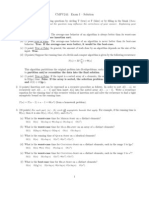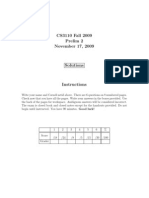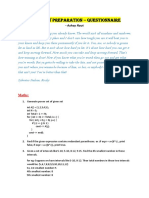Linear Regression
Linear Regression
Uploaded by
Saad AhmedCopyright:
Available Formats
Linear Regression
Linear Regression
Uploaded by
Saad AhmedOriginal Description:
Copyright
Available Formats
Share this document
Did you find this document useful?
Is this content inappropriate?
Copyright:
Available Formats
Linear Regression
Linear Regression
Uploaded by
Saad AhmedCopyright:
Available Formats
Data Structure and Algorithm I Midterm Examination 120 points Time: 9:10am-12:10pm (180 minutes), Friday, November 12,
2010 Problem 1. In each of the following question, please specify if the statement is true or false. If the statement is true, explain why it is true. If it is false, explain what the correct answer is and why. (40 points. For each question, 2 points for the true/false answer and 3 points for the explanations.) 1. n1.5 = O(n log n). Ans:Flase Assume that n1.5 = O(n log n) i.e. there exist positive constants n0 and c such that n1.5 c(n log n) for all n n0 , then we can get greater than
n 1. 5 n log n n 1. 5 n log n
c. But there is no constant
. So the assumption leads to contradiction.
2. A complete binary tree with a height of h can have more nodes than a full binary tree with a height of h. Ans:Flase A complete binary tree with a height of h have 2h1 to 2h 1 nodes. A complete binary tree with a height of h have 2h 1 nodes.
3. A stack follows a FIFO (rst-in-rst-out) rule. Ans:False A stack follows a FILO (rst-in-last-out) rule.
4. When we use a max heap to implement a priority queue, the time complexity of both the add and delete operations are O(n). Ans:True The operation add() and delete() spend O( the height of min heap ). Because the min heap is a complete tree, the height of min heap log n. the time complexity of add() and delete() = O(log n) = O(n) 1
5. T (n) = T (n 1) + n, T (1) = 1. Then T (n) = O(n3 ). Ans:True
T(n)
=T(n-1)+n
T(n-1)=T(n-2)+n-1 ... + T(2) =T(1) +2
____________________________ T(n)=1+2+...+n=n(n+1)/2
Then we get T (n) = O(n2 ) = O(n3 ).
6. In a circular doubly linked list with 10 nodes, we will need to change 4 links if we want to delete a node other than the head node. Ans:False We can change the link elds of the nodes that precede and follow the node we want to delete. So we just need to change 2 links if we want to delete a node other than the head node.
7. If f1 (n) = (g1 (n)) and f2 (n) = (g2 (n)), then f1 (n) f2 (n) = (g1 (n) g2 (n)). Ans:True f1 (n) = (g1 (n)) there exist positive constants n1 and c1 such that f1 (n) c1 g1 (n) for all n n1 f2 (n) = (g2 (n)) there exist positive constants n2 and c2 such that f2 (n) c2 g2 (n) for all n n2
So we can nd positive constants c = c1 c2 and n0 = max{n1 , n2 } such that 2
f1 (n) f2 (n) cg1 (n) g2 (n) for all n n0 . Then f1 (n) f2 (n) = (g1 (n) g2 (n)).
8. When using linked list to perform insertion sort, each time we remove an element from the input list and insert it to the correct position in the linked list. Assume that we have n numbers to be sorted, the time complexity for sorting these numbers using the insertion sort algorithm is O(n2 ). Ans:True The worst case is that we have to search all numbers in the list before we insert a new number. 1 + 2 + .. + n = n(n 1)/2 The time complexity for sorting these numbers using the insertion sort algorithm is O(n2 ).
Problem 2. Fill the blank. (20 points. 5 points for each question.) 1. Please compute The failure function (in Knuth, Morris, and Pratts pattern matching algorithm) for the pattern string abaabaab in Table 1. 2. Please draw all the threads of the threaded tree shown in Figure 7. 3. Please complete Table 2 to show the progress of converting the inx expression 2+1-(4-3*1)*3 to its postx expression using a stack. 4. Please complete the following function to concatenate two circularly singly linked list into one circularly singly linked list. typedef struct listNode * listPointer; typedef struct listNode { int data; listPointer link; }; 3
listPointer concatenate(listPointer list1, listPointer list2) {
/* Produce a new list which contains list1 followed by list2. Return the pointer which points to the new list. The arguments list1 and list2 point to the tails of the lists.*/
listPointer temp;
if (list1==NULL) return list2; if (list2==NULL) return list1;
listPointer tmp = list1->link; list1->link = list2->link; list2->link = tmp;
return list2; } Problem 3. The Tower of Hanoi is a mathematical game. The game consists of 3 rods, and n disks of dierent sizes which can slide onto any rod. The puzzle starts with the disks stack in ascending order of size on rod number 1 (the smallest disk is on the top). The objective of the game is to move the entire stack to rod number 3, obeying the following rules: 1. Only one disk can be moved at a time. 2. Each move consists of taking the upper disk from one of the rods and sliding it onto another rod, on top of the other disks that may already be present on that rod. 3. No disk may be placed on top of a smaller disk. 4
In this problem, please write an algorithm using the recursive technique to output a series of moves which solve the Tower of Hanoi problem. The input and output are as follows: Input: one single number which represents the number of disks on the rod Output: Each line of output consists of a pair (i, j ), which represents a move from rod number i to rod number j . The sequence of moves should move the entire stack from rod number 1 to rod number 3. Example: Input: 3 Output: (1,3) (1,2) (3,2) (1,3) (2,1) (2,3) (1,3)
(10 points)
Ans: hanoi(from, tmp, to, n){ if(n==1){ move(from,to); return; } hanoi(from, to, tmp, n-1); printf ( "(%d,%d)", from, to ); 5
hanoi(tmp, from, to, n-1); return; }
Problem 4. A lower triangular matrix is one in which all elements above the main diagonal of a square matrix are zero. Assume that we have a lower triangular matrix L with n rows (Figure 2). Please answer the following related questions: (10 points) 1. What is the total number of nonzero terms of L (3 points)? If each element can be stored in a 32-bit signed integer, how much memory would be needed to store all the nonzero elements of matrix L (2 points)? Ans: (a) 1 + 2+. . . +n = (b) 32
n(n+1) 2 n(n+1) 2
= 16(n2 + n) bits.
2. Since storing a triangular matrix as a two dimensional array wastes sapce, we would like to nd a way to store only the nonzero terms in the triangular matrix. Find an addressing formula for the elements Li,j to be stored in a one dimensional array a. In other words, where in the array a would you store the element Li,j ? (You only need to explain how to map each nonzero element to the one dimensional array. No need to write down the actual function.) (5 points) Ans: Pack the traiagular matrix into array a row by row like the following Fig 1
Figure 1: Stored into array a
1 + 2 + + (i 1) + j 1 =
i2 i (1 + i 1) (i 1) + (j 1) = + (j 1) 2 2 6
The minus one is because we store the rst element at a[0]. Problem 5. In the following questions, consider the list of numbers: 62, 31, 70, 91, 25, 11, 9, 61, 73, 6. (20 points) 1. Show the result of inserting the numbers in the list in the same order specied above into an initially empty minimum heap. Note that you need to show how the heap looks like after each number is inserted. (5 points) Ans: Here shows the 3 middle trees of the results. see Figure 3. 2. Show the result of inserting the numbers in the list in the same order specied above into an initially empty binary search tree. Note that you need to show how the binary search tree looks like after each number is inserted. (5 points) Ans: Here shows the 3 middle trees of the results. see Figure 4. 3. Use the binary search tree you created in question 2. What are the two possible binary search trees after 62 is deleted? (5 points) Ans: see Figure 5. 4. Explain how you can utilize a minimum heap to sort the list of numbers in descending order. (3 points) Let n be the number of elements in the list. What is the time complexity of your sorting algorithm? (2 points) Ans: (1) step1: Delete the root from the min heap and put it into stackA. O(1) step2: Restructure the min heap. O(log n) step3: Go step1 until the min heap is empty. n times step4: Pop items from stackA.(The result is in descending order.) O(n) (2) O(n log n) Problem 6. In this problem, we consider logic expressions with the following operands and operators: Operands: 0 and 1, which represents false and true, respectively. 7
Operators: & (and), | (or), and ! (not). Note that you also have to consider left and right parenthesis. The precedences of the three operators are ! > & > |. (25 points) 1. Draw the logical expression tree of the expression !(0&!1&0|0)&0. Since ! (not) is an unary operator, we ask you to put its only operand to its right child. (3 points) Write down its prex expression. (2 points) (a) See Figure 6 (b) Prex: & ! | & & 0 ! 1 0 0 0 2. Please write down an algorithm to take a string of logic expression and convert it to an expression tree. You can use any data structure you like to represent the tree. Since ! (not) is an unary operator, we ask you to put its only operand to its right child. However, please explain how your data structure relate to the tree logically in details. (Comment: this is the hardest question in this exam. Do this after you nish all other questions!) (10 points) (a) Observe that the higher precedence the operator is, the lower level the corresponding tree node will be. (b) Dene isp[] as in-stack-precedence and icp[] as incoming-precedence. (c) typedef struct ExpNode{ ExpNode *left, *right; op v; /*if the node represent digit, v is the value; if not, v is the operator*/ }; int icp[] = {7, 1, 5, 4, 3}; /*( ) ! & |*/ int isp[] = {2, 1, 5, 4, 3}; /*( ) ! & |*/
ToExpTree (Exp input){ Create Stack1 for operator; Create Stack2 for ExpNode; 8
//read the string left to right while(end of input is not reached) { read from input, store at v1 if(v1 == digit) { create ExpNode k for v1; push k into Stack2; }else /*v1 is & | ! ( )*/ { if(Stack1 is empty || the icp of v1 > isp of Stack1[top]) push v1 into Stack1; else { while(the icp of v1 <= isp of Stack1[top]) { if(Stack1[top] is "(") { pop Stack1; break; } op1 = pop Stack1; creat ExpNode t for op1; r = pop Stack2; t->right = t; if(op1 is & or |) { l = pop Stack2; t->left = l; } 9
push t into Stack2; } push v1 into Stack1; } } } } 3. Please write down an algorithm to evaluate the outcome of the logical expression using the tree generated by your algorithm in question 1. (5 points) (a) Postorder traversal (b) typedef struct ExpNode{ ExpNode *left, *right; int type; /*digit or operator*/ int value; }; cal(ExpNode *tree){ if(!tree){ cal(tree->left); cal(tree->right); if(tree->type is equal to operator & |) tree->value = (tree->left->value) op (tree->right->value); else if(tree->type is equal to operator !) tree->value = !(tree->right->value); } } 4. Please write down an algorithm to output the prex expression of the logic expression using the tree generated by your algorithm in question 1. (5 points) (a) Preorder traversal 10
(b) typedef struct ExpNode{ ExpNode *left, *right; op v; /*if the node represent digit, v is the value; if not, v is the operator*/ }; pre(ExpNode *tree){ if(!tree){ printf(tree->v); pre(tree->left); pre(tree->right); } } Problem 7. Please provide constructive suggestions to this course in terms of lectures, homeworks, or any other aspects. (5 points)
11
Figure 2: A Lower Triangular Matrix
Table 1: The failure function for the KMP algorithm b -1 a -1 b 0 c -1 b 0 c -1 b 0 a 1 b 2 c 3 b 4 a 1 b 2 c 3
Table 2: The progress of converting the inx expression 2+1-(4-3*1)*3 to its postx expression Token 2 + 1 ( 4 3 * 1 ) * 3 + + -( -( -(-(-(-* -(-* -* Stack content (bottom to top) Output so far 2 2 21 21+ 21+ 21+4 21+4 21+43 21+43 21+431 21+431*21+431*21+431*-3*-
12
25
31 31 70
11
11
61 82 62 91
62
70
25
61
31
70
25
91
73
62
Figure 3: 5-1
62
62
62
31 31 70
70
31
70
25 25 91 11
61
91
25
61
91
11
73
Figure 4: 5-2
61
70
31
70
31
91
25
91
25
61
73
11
73
11
Figure 5: 5-3
13
Figure 6: Expression Tree
Figure 7: Memory representation of a threaded tree
14
You might also like
- Neetcode 150 SolutionDocument74 pagesNeetcode 150 Solutionguna0proNo ratings yet
- Cairn of The Winter KingDocument32 pagesCairn of The Winter KingKyouko Oshima100% (10)
- FSM Haccp Butter ChickenDocument26 pagesFSM Haccp Butter ChickenAYMAN ZEHRANo ratings yet
- Mgt657 Individual AssignmentDocument12 pagesMgt657 Individual AssignmentSuct Wadi75% (4)
- What The Bible Says About Child Training ExcerptsDocument12 pagesWhat The Bible Says About Child Training Excerptsfourbzboysmom100% (1)
- Introduction To Algorithms: Problem Set 1 SolutionsDocument5 pagesIntroduction To Algorithms: Problem Set 1 Solutionssasan_codeNo ratings yet
- Exam SolDocument4 pagesExam SolgsandynitwNo ratings yet
- DSA Assignment 1-SolutionsDocument10 pagesDSA Assignment 1-SolutionsChatianya ChaniyaraNo ratings yet
- CS3110 Prelim 2 SP09Document9 pagesCS3110 Prelim 2 SP09Lee GaoNo ratings yet
- Cs301 Solved Subjective Final Term by JunaidDocument39 pagesCs301 Solved Subjective Final Term by JunaidTayyab AliNo ratings yet
- Problem SetDocument2 pagesProblem SetGobara DhanNo ratings yet
- Quiz1 Set1Document2 pagesQuiz1 Set1Sambhav SingwiNo ratings yet
- CS301 Data Structures Final Term of 2012 Solved Subjective With References by MoaazDocument34 pagesCS301 Data Structures Final Term of 2012 Solved Subjective With References by MoaazTayyabah Shah67% (3)
- Cse373 11au Midterm1.key PDFDocument10 pagesCse373 11au Midterm1.key PDFanamNo ratings yet
- CS301 Final Term Solved SUBJECTIVE by JUNAIDDocument39 pagesCS301 Final Term Solved SUBJECTIVE by JUNAIDMoon100% (1)
- MCQs On Array Data Structure With AnswersDocument20 pagesMCQs On Array Data Structure With AnswersProkash BarmanNo ratings yet
- Test 2: Compsci 100: Owen Astrachan November 12, 2008Document10 pagesTest 2: Compsci 100: Owen Astrachan November 12, 2008Gobara DhanNo ratings yet
- 1 Complexity and RecursionDocument6 pages1 Complexity and RecursionShuvadeep DasNo ratings yet
- Python Week 4 GA Sols ?Document23 pagesPython Week 4 GA Sols ?Gautam BhardwajNo ratings yet
- Key P1Document3 pagesKey P1James RobertNo ratings yet
- Solutions To Google Top Interview PuzzlesDocument7 pagesSolutions To Google Top Interview Puzzlesnothing nobodyNo ratings yet
- DSANotesDocument30 pagesDSANotesShivangi AgrawalNo ratings yet
- Tut Divide ProblemsDocument7 pagesTut Divide ProblemsTimothy KurbyNo ratings yet
- Number Systems: 1.1 Problems NS-1Document5 pagesNumber Systems: 1.1 Problems NS-1Dean JNo ratings yet
- MIT6 006F11 Quiz1 SolDocument13 pagesMIT6 006F11 Quiz1 Solmuhammadshariqali39No ratings yet
- Accolite QPPDocument8 pagesAccolite QPPgowthami jainNo ratings yet
- Test 1: CPS 100: Owen Astrachan October 1, 2004Document14 pagesTest 1: CPS 100: Owen Astrachan October 1, 2004Gobara DhanNo ratings yet
- COMP 171 Data Structures and Algorithms Spring 2005Document12 pagesCOMP 171 Data Structures and Algorithms Spring 2005Gobara DhanNo ratings yet
- GATE OverflowDocument485 pagesGATE Overflowlokenders801No ratings yet
- Owen Astrachan and Dee Ramm November 19, 1996Document11 pagesOwen Astrachan and Dee Ramm November 19, 1996Gobara DhanNo ratings yet
- Test 2: Compsci 100: Owen Astrachan November 11, 2009Document9 pagesTest 2: Compsci 100: Owen Astrachan November 11, 2009Gobara DhanNo ratings yet
- SodapdfDocument16 pagesSodapdfJoel JoNo ratings yet
- Cse373 12wi Midterm1.KeyDocument10 pagesCse373 12wi Midterm1.KeyRitu PhogatNo ratings yet
- CM20254 Exam 2020 SolutionDocument8 pagesCM20254 Exam 2020 SolutionYufan YeNo ratings yet
- CSC323 Spring2016 QB Module 2 Classical Design TechniquesDocument17 pagesCSC323 Spring2016 QB Module 2 Classical Design TechniquesUmar UmarNo ratings yet
- Prob 1Document2 pagesProb 1Mrudula VaradeNo ratings yet
- SHORT QUESTIONS (6 Points Each) : N I 1 N I 1 I 2Document6 pagesSHORT QUESTIONS (6 Points Each) : N I 1 N I 1 I 2Gobara DhanNo ratings yet
- Sample Programs For Practice 2Document31 pagesSample Programs For Practice 2RajkumarNo ratings yet
- Data Structure QuestionsDocument13 pagesData Structure QuestionsSesa Singha RoyNo ratings yet
- CS510 ProblemSet 3 Divide N ConquerDocument5 pagesCS510 ProblemSet 3 Divide N ConquerAyush PatelNo ratings yet
- Int Int: #IncludeDocument6 pagesInt Int: #IncludedsmariNo ratings yet
- (A) What Is Randomized Quicksort? Analyse The Expected Running Time of Randomized Quicksort, With The Help of A Suitable Example. AnswerDocument14 pages(A) What Is Randomized Quicksort? Analyse The Expected Running Time of Randomized Quicksort, With The Help of A Suitable Example. Answershriya2011No ratings yet
- Exercises 1.2Document13 pagesExercises 1.2Mahdi HallakNo ratings yet
- Final Extra PracticeDocument4 pagesFinal Extra PracticeaddisulalNo ratings yet
- NAMEDocument8 pagesNAMEa61467780No ratings yet
- Ada 1Document11 pagesAda 1kavithaangappanNo ratings yet
- Sorting in CDocument18 pagesSorting in CAnand DuraiswamyNo ratings yet
- ICS 211, Design & Analysis of Algorithms, Assignment 1Document3 pagesICS 211, Design & Analysis of Algorithms, Assignment 1Pratik RajNo ratings yet
- Interview Preparation Best 100 Ashay Raut PDFDocument18 pagesInterview Preparation Best 100 Ashay Raut PDFAditya ChowdaryNo ratings yet
- Interview Preparation Best 100 Ashay RautDocument18 pagesInterview Preparation Best 100 Ashay RautSatyendra MauryaNo ratings yet
- Cs4102 Hw3 SolutionsDocument4 pagesCs4102 Hw3 Solutionsumbrella0No ratings yet
- ExercisesDocument42 pagesExercisesyahiapcuserNo ratings yet
- Owen Astrachan November 19, 1997: #IncludeDocument9 pagesOwen Astrachan November 19, 1997: #Includesatya_baralNo ratings yet
- Data Structure ExamDocument6 pagesData Structure ExamAyesha A. RahmanNo ratings yet
- Discrete Structures Practice ProblemDocument6 pagesDiscrete Structures Practice ProblemAyesha A. RahmanNo ratings yet
- Analysis of Algorithms (CS-318) Assignment: InstructionsDocument5 pagesAnalysis of Algorithms (CS-318) Assignment: InstructionsHina jamilNo ratings yet
- Bisma Ali - AssignmentDocument5 pagesBisma Ali - AssignmentHina jamilNo ratings yet
- CS2705 Tut1 SolDocument4 pagesCS2705 Tut1 SolPuneet SangalNo ratings yet
- Homework 3Document5 pagesHomework 3api-392421774No ratings yet
- Midterm CS-435 Corazza Solutions Exam B: I. T /F - (14points) Below Are 7 True/false Questions. Mark Either T or F inDocument8 pagesMidterm CS-435 Corazza Solutions Exam B: I. T /F - (14points) Below Are 7 True/false Questions. Mark Either T or F inRomulo CostaNo ratings yet
- COMP4500 - 7500 - 2011, Sem 2Document8 pagesCOMP4500 - 7500 - 2011, Sem 2ekampreetNo ratings yet
- Csci2100a Estr2102 HWDocument135 pagesCsci2100a Estr2102 HWAsdasd SdasNo ratings yet
- Regner v. Logarta (CivPro - Summons)Document3 pagesRegner v. Logarta (CivPro - Summons)Cathy AlcantaraNo ratings yet
- Ethics, Integrity, and Aptitude ContentDocument5 pagesEthics, Integrity, and Aptitude ContentLian GuiteNo ratings yet
- Business Process Management in A Manufacturing Enterprise: An OverviewDocument10 pagesBusiness Process Management in A Manufacturing Enterprise: An OverviewMithilesh RamgolamNo ratings yet
- 21ST Century SchoolsDocument2 pages21ST Century SchoolsrebutiacomichaelaNo ratings yet
- Verbal Tenses2nd Bat 2Document52 pagesVerbal Tenses2nd Bat 2nazhaNo ratings yet
- 20 Short Dua To Read EverydayDocument23 pages20 Short Dua To Read EverydayAbdulkarim AhmadNo ratings yet
- Circulationaha 117 027966 FullDocument61 pagesCirculationaha 117 027966 Fulloliver_vigoNo ratings yet
- 7 Guidelines For Teaching ListeningDocument2 pages7 Guidelines For Teaching ListeningElveEuzilaYanJulianNo ratings yet
- CH4: The Zone of Canadian Aboriginal Adult Education: A Social Movement ApproachDocument13 pagesCH4: The Zone of Canadian Aboriginal Adult Education: A Social Movement ApproachKawinNo ratings yet
- Transformers, How Do They Work?: Generative AI To Create ContentDocument14 pagesTransformers, How Do They Work?: Generative AI To Create ContentAntony AlexNo ratings yet
- Transitive and IntransitiveDocument3 pagesTransitive and IntransitiveJhermaine Audrey GomezNo ratings yet
- How To Be More RationalDocument4 pagesHow To Be More RationalHan YiNo ratings yet
- Inclined Plane Experiment NewestDocument3 pagesInclined Plane Experiment Newestapi-238942037No ratings yet
- Jadual Berkala Unsur ModenDocument1 pageJadual Berkala Unsur Modenfidaakookie99No ratings yet
- VowDocument2 pagesVowClaudine EsmajerNo ratings yet
- Desai STOPMIPDocument13 pagesDesai STOPMIPNedson GundoNo ratings yet
- Activity 3 in StatDocument13 pagesActivity 3 in StatIanna ManieboNo ratings yet
- (But Not Me, I'm Fabulous! God Made Sure of That.) : "30 Things That SCARE Women About Themselves!"Document40 pages(But Not Me, I'm Fabulous! God Made Sure of That.) : "30 Things That SCARE Women About Themselves!"Noor ElbadriNo ratings yet
- CTR 8500-8300 3.4.0 QoS Configuration - July2017Document43 pagesCTR 8500-8300 3.4.0 QoS Configuration - July2017Sandra Milena ViracachaNo ratings yet
- LUMILAN, Deseree BSN 1-Y1-2 (Course Task Cu13) PDFDocument2 pagesLUMILAN, Deseree BSN 1-Y1-2 (Course Task Cu13) PDFDeseree C. Lumilan100% (1)
- Quan Li - Economic Globalization and DemocracyDocument27 pagesQuan Li - Economic Globalization and DemocracyNatalia GuinsburgNo ratings yet
- Leading Psychiatrist Blows Whistle On ProfessionDocument9 pagesLeading Psychiatrist Blows Whistle On ProfessionpicogyoNo ratings yet
- LABMAN 1-2.1: Management ProcessDocument5 pagesLABMAN 1-2.1: Management ProcessAlondra SagarioNo ratings yet
- Cases of Personal PronounsDocument2 pagesCases of Personal PronounsAsle Joyce Pameroyan FloresNo ratings yet
- Designing Listening Task SMADocument8 pagesDesigning Listening Task SMAJaenal AbidinNo ratings yet
- IkeaDocument22 pagesIkeayosephatsuryodiningr100% (1)

























































































